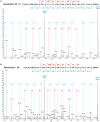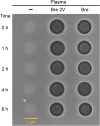Brevibacillin 2V, a Novel Antimicrobial Lipopeptide With an Exceptionally Low Hemolytic Activity
- PMID: 34220785
- PMCID: PMC8245773
- DOI: 10.3389/fmicb.2021.693725
Brevibacillin 2V, a Novel Antimicrobial Lipopeptide With an Exceptionally Low Hemolytic Activity
Abstract
Bacterial non-ribosomally produced peptides (NRPs) form a rich source of antibiotics, including more than 20 of these antibiotics that are used in the clinic, such as penicillin G, colistin, vancomycin, and chloramphenicol. Here we report the identification, purification, and characterization of a novel NRP, i.e., brevibacillin 2V (lipo-tridecapeptide), from Brevibacillus laterosporus DSM 25. Brevibacillin 2V has a strong antimicrobial activity against Gram-positive bacterial pathogens (minimum inhibitory concentration = 2 mg/L), including difficult-to-treat antibiotic-resistant Enterococcus faecium, Enterococcus faecalis, and Staphylococcus aureus. Notably, brevibacillin 2V has a much lower hemolytic activity (HC50 > 128 mg/L) and cytotoxicity (CC50 = 45.49 ± 0.24 mg/L) to eukaryotic cells than previously reported NRPs of the lipo-tridecapeptide family, including other brevibacillins, which makes it a promising candidate for antibiotic development. In addition, our results demonstrate that brevibacillins display a synergistic action with established antibiotics against Gram-negative bacterial pathogens. Probably due to the presence of non-canonical amino acids and D-amino acids, brevibacillin 2V showed good stability in human plasma. Thus, we identified and characterized a novel and promising antimicrobial candidate (brevibacillin 2V) with low hemolytic activity and cytotoxicity, which can be used either on its own or as a template for further total synthesis and modification.
Keywords: Brevibacillus; Enterococcus; NRPS; Staphylococcus; antimicrobial activity; brevibacillin; lipopeptide.
Copyright © 2021 Zhao, Wang, Shukla, Kumar, Weingarth, Breukink and Kuipers.
Conflict of interest statement
The authors declare that the research was conducted in the absence of any commercial or financial relationships that could be construed as a potential conflict of interest.
Figures





Similar articles
-
Brevibacillin 2V Exerts Its Bactericidal Activity via Binding to Lipid II and Permeabilizing Cellular Membranes.Front Microbiol. 2021 Jul 16;12:694847. doi: 10.3389/fmicb.2021.694847. eCollection 2021. Front Microbiol. 2021. PMID: 34335524 Free PMC article.
-
Isolation and Structural Elucidation of Brevibacillin, an Antimicrobial Lipopeptide from Brevibacillus laterosporus That Combats Drug-Resistant Gram-Positive Bacteria.Appl Environ Microbiol. 2016 Apr 18;82(9):2763-2772. doi: 10.1128/AEM.00315-16. Print 2016 May. Appl Environ Microbiol. 2016. PMID: 26921428 Free PMC article.
-
Discovery of a Novel Antimicrobial Lipopeptide, Brevibacillin V, from Brevibacillus laterosporus fmb70 and Its Application on the Preservation of Skim Milk.J Agric Food Chem. 2019 Nov 13;67(45):12452-12460. doi: 10.1021/acs.jafc.9b04113. Epub 2019 Nov 1. J Agric Food Chem. 2019. PMID: 31674183
-
Treatment options for vancomycin-resistant enterococcal infections.Drugs. 2002;62(3):425-41. doi: 10.2165/00003495-200262030-00002. Drugs. 2002. PMID: 11827558 Review.
-
Antimicrobial peptides produced by Brevibacillus spp.: structure, classification and bioactivity: a mini review.World J Microbiol Biotechnol. 2018 Mar 29;34(4):57. doi: 10.1007/s11274-018-2437-4. World J Microbiol Biotechnol. 2018. PMID: 29594558 Review.
Cited by
-
Underexplored bacteria as reservoirs of novel antimicrobial lipopeptides.Front Chem. 2022 Oct 5;10:1025979. doi: 10.3389/fchem.2022.1025979. eCollection 2022. Front Chem. 2022. PMID: 36277345 Free PMC article. Review.
-
Discovery of a Novel Antimicrobial Peptide from Paenibacillus sp. Na14 with Potent Activity Against Gram-Negative Bacteria and Genomic Insights into Its Biosynthetic Pathway.Antibiotics (Basel). 2025 Aug 6;14(8):805. doi: 10.3390/antibiotics14080805. Antibiotics (Basel). 2025. PMID: 40867999 Free PMC article.
-
Effects of a novel Bacillus subtilis GXYX crude lipopeptide against Salmonella enterica serovar Typhimurium infection in mice.Heliyon. 2024 Mar 15;10(6):e28219. doi: 10.1016/j.heliyon.2024.e28219. eCollection 2024 Mar 30. Heliyon. 2024. PMID: 38524560 Free PMC article.
-
Antibacterial Regularity Mining Beneath the Systematic Activity Database of Lipopeptides Brevilaterins: An Instructive Activity Handbook for Its Food Application.Foods. 2022 Sep 26;11(19):2991. doi: 10.3390/foods11192991. Foods. 2022. PMID: 36230066 Free PMC article.
-
Brevibacillin 2V Exerts Its Bactericidal Activity via Binding to Lipid II and Permeabilizing Cellular Membranes.Front Microbiol. 2021 Jul 16;12:694847. doi: 10.3389/fmicb.2021.694847. eCollection 2021. Front Microbiol. 2021. PMID: 34335524 Free PMC article.
References
-
- Andraö J., Monreal D., de Tejada G. M., Olak C., Brezesinski G., Gomez S. S., et al. (2007). Rationale for the design of shortened derivatives of the NK-lysin-derived antimicrobial peptide NK-2 with improved activity against Gram-negative pathogens. J. Biol. Chem. 282 14719–14728. 10.1074/jbc.m608920200 - DOI - PubMed
-
- Ciornei C. D., Sigurdardóttir T., Schmidtchen A., Bodelsson M. (2005). Antimicrobial and chemoattractant activity, lipopolysaccharide neutralization, cytotoxicity, and inhibition by serum of analogs of human cathelicidin LL-37. Antimicrob. Agents Chemother. 49 2845–2850. 10.1128/aac.49.7.2845-2850.2005 - DOI - PMC - PubMed
LinkOut - more resources
Full Text Sources
Molecular Biology Databases
Miscellaneous

